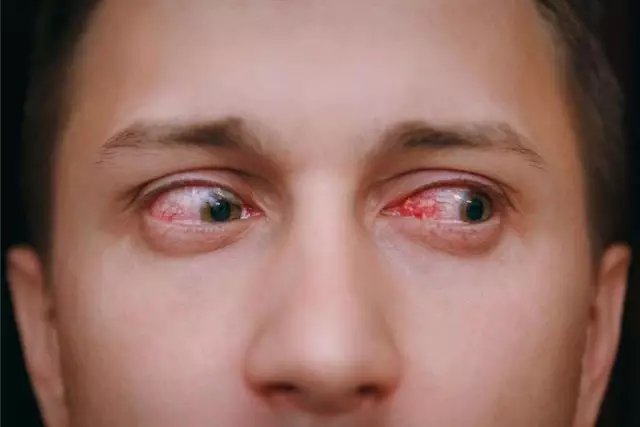- Author Rachel Wainwright [email protected].
- Public 2023-12-15 07:39.
- Last modified 2025-11-02 20:14.
Dry eye syndrome

Dry eye syndrome is a lack of hydration of the cornea, as a result of which it dries out and loses its function. Normally, the eye is constantly hydrated, this is one of the conditions for its normal functioning. With a lack of moisture, the so-called dry eye syndrome develops, which has a number of characteristic signs, as well as formidable consequences.
It can develop as a primary, independent disease, or it can be one of the symptoms of another disease, but whatever the cause of dry eye syndrome, it can lead to partial or complete loss of vision, and therefore requires close attention.
The mechanism of development of dry eye syndrome
Moisturization of the eye occurs due to the protective film on the eye that covers the cornea, and the produced tear fluid, which constantly wets it. The protective film consists of three layers:
- The surface layer is formed by lipids, i.e. fats that protect the film from moisture evaporation.
- The middle layer - consists of the tear fluid, its task is nutrition, protection of the cornea and a certain visual function, since the presence of this layer changes light refraction
- The mucous, or mucinous layer - adheres tightly to the cornea, protecting it and serving as the basis for the other two layers of the protective film.
In addition, a healthy eye constantly contains a small amount of tear fluid, which washes it when blinking. The lacrimal fluid has a complex composition, it is produced by a whole group of glands, 2 ml daily in a calm emotional state, because, as you know, in the event of emotional upheavals, the production of tear fluid increases sharply. In addition to the system for the production of tear fluid, there is also a system for the outflow of excess moisture from the eye. With the help of the lacrimal canal, excess tears drain into the nasal cavity, which becomes very noticeable when a person cries - he always has nasal discharge. Also, the drainage system allows the tear fluid to be renewed and perform the function of nourishing the cornea.
Causes of dry eye syndrome
Failure at any stage in the production or outflow of tear fluid can lead to dry eye syndrome. This can be a violation of tear formation, poor quality of the formed film (for example, a thinned lipid layer, which leads to its drying out), uneven distribution of the protective film over the cornea.
Dry eye syndrome can be caused by various conditions and diseases.
The most common causes of dry eye syndrome are:
- vitamin deficiency, especially a violation of the metabolism of fat-soluble vitamins (A);
- diseases of the endocrine glands, i.e. endocrine diseases;
- systemic diseases in which connective tissue is affected;
- hormonal disruption, for example, during the onset of menopause;
- improperly fitted contact lenses;
- some medicinal products incl. antihypertensive drugs;
- violation of the mode of work with a computer. In this case, dry eye syndrome has several synonyms: eye office syndrome, computer vision syndrome, etc.
- poor environmental situation.
Age can also act, if not as a cause of dry eye syndrome, then as a factor contributing to its development, since the older the age group, the more frequent the cases of the disease. After the age of 40, about 30% of people are affected by dry eye syndrome. As a result of the lower stability of the hormonal background and the direct dependence of the production of tear fluid on hormones, the symptoms of dry eye syndrome appear in women more often than in men.
Dry eye symptoms
Symptoms of dry eye include the following:
- redness of the eyes, especially after activities that require them to strain;
- burning sensation and pain in the eyes;
- increased tearing, which at first glance seems paradoxical. In fact, it is a compensatory mechanism triggered by the body to eliminate corneal dryness;
- painful reaction to the instillation of drops of any composition into the eyes, even without any irritants
- poor tolerance to wind, smoke, air conditioning.
According to the degree of manifestation of symptoms of dry eye syndrome, several clinical forms of the disease are distinguished: mild, moderate, severe and extremely severe.
Diagnosis of dry eye syndrome
Diagnosis of dry eye syndrome is carried out in several directions: examination of the cornea with the definition of dry lesions, for which special staining solutions are used. Then the production of tear fluid is examined using special samples, as well as its outflow. A complete ophthalmological examination is carried out, including a laboratory study of the composition of the tear fluid. If you suspect that systemic or endocrine diseases could be the cause of dry eye syndrome, immunological and endocrinological examinations are carried out, respectively.
Dry eye treatment
Depending on the cause of dry eye syndrome, treatment can be undertaken in one of the following ways, or a combination of both:
- stimulating the production of tear fluid;
- obstruction of the outflow of tear fluid;
- artificial replacement of tear fluid;
- decreased evaporation of tear fluid.
The most effective treatment for dry eye syndrome in its moderate to severe forms is to inhibit tear drainage. This can be achieved in two ways - surgical, in which obturation of the lacrimal glands is performed, in other words, their intersection, as a result of which the fluid does not enter the nasal cavity, and orthopedic - by making a special obturator, a miniature "plug" that blocks the lacrimal canal. The second method is currently more preferable in the treatment of dry eye syndrome, since, firstly, it does not cause irreversible changes, secondly, the current generation of silicone used for the manufacture of the obturator does not cause allergic reactions, and thirdly, no surgical intervention is required …
In some cases, when no pathology is detected, and the drying out of the cornea is the result of improperly organized work with a computer or books.
It should be noted that even in mild cases that seem insignificant, it is imperative to treat dry eye syndrome, since otherwise it can lead to severe diseases of the conjunctiva and cornea, and subsequently to loss of vision.
The use of drugs such as "artificial tear"
The easiest way to manage dry eye is to use tear replacement medications. They prevent drying out, and although they do not fundamentally solve the problem, since they do not eliminate the cause, they help to avoid the negative consequences associated with drying out the cornea.
As an example, here are three new artificial tear preparations.
Cationorm
This drug is a unique cationic emulsion for moisturizing the ocular surface, capable of restoring all layers of the tear film. If you use the drug in the morning, your eyes will be protected from dryness and discomfort all day. It is important that taking Cationorm stops the progression of dry eye syndrome. The advantages are the absence of preservatives and the ability to use when wearing contact lenses, even if they are worn constantly (more than 6 months in a row, more than 5 days a week, more than 10 hours a day).
Who is Cationorm shown to:
- people with severe dry eye syndrome associated with professional activities;
- people who experience discomfort and dry eyes in the morning;
- people receiving hormone replacement therapy;
- people with eye diseases in which there are problems with the lacrimal fluid (allergic conjunctivitis, blepharitis, glaucoma, etc.).
Oftagel
Eye gel containing the highest concentration of carbomer. Its advantage is that there is no need to often bury the eyes, it is enough to apply it once a day at night. This dose is enough to effectively moisturize and eliminate lacrimation throughout the day. Suitable for people with periodic manifestations of dry eye syndrome, especially those who do not have the opportunity to regularly drip eye drops.
Okutiars
A drug in the form of eye drops containing ultra-high molecular weight hyaluronic acid. Effectively eliminates the manifestations of dry eye syndrome, relieves fatigue and discomfort. Its advantages: despite the fact that it does not contain preservatives, it can be stored for 6 months when opened; compatible with contact lenses.
Suitable for:
- people learning to use lenses;
- people who experience eye fatigue and discomfort due to increased eye strain (students, drivers, programmers, etc.) periodically, in the late afternoon;
- patients recovering from ophthalmic operations (corneal surgery, cataract removal, LASIK, photorefractive keratectomy).
YouTube video related to the article:
The information is generalized and provided for informational purposes only. At the first sign of illness, see your doctor. Self-medication is hazardous to health!






